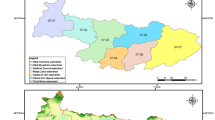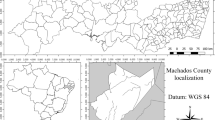Abstract
Stereo Cartosat-1 satellite data was processed to generate high spatial resolution digital elevation model (DEM) using ground control points (GCPs) collected through geodetic single frequency GPS in differential GPS mode. DEM was processed to generate bare earth DEM by removing heights of natural and man made features from DEM. The bare earth DEM was further analysed in GIS environment to generate terrain-topographic indices viz. wetness index (WI), stream power index (SPI) and sediment transport index (STI) to characterize topographic potential of soil erosion. Hillslopes in the studied watershed (part of Shiwalik hills of Dehradun district, Uttarakhand state) were characterized as low wetness index values indicating dry areas whereas high wetness index values at lower reaches of the watershed indicating as possible source areas for generation of saturated overland flow. Higher STI values were observed in hilly as well as upper part of the piedmont plain and at along sides of the streams in upper piedmont indicating areas susceptible to severe soil erosion. GIS based these topographic indices provided an easy and quick appraisal and scientific basis to identify spatial variability of soil erosion risk in a hilly watershed.
Similar content being viewed by others
References
Beven KJ and Kirkby MJ (1979) A physically based variable contributing area model of basin hydrology. Hydrol Sci Bul, 24(1):43–69
Beven KJ and Kirkby MJ (1993) In: K Beven and MJ Kirkby, Editors, Channel Network Hydrology, Wiley, Chichester
Burrough PA (1986) Principal of Geographical Information Systems for Land Resource Assessment. Clarendon Press, Oxford. pp. 193
Burrough PA and McDonnell RA (1998) Principles of Geographical Information Systems. Oxford University Press, England
CSWCRTI (2004) Information Broucher of Central Soil and Water Conservation Research & Training Institute Research Farm, Selakui, Dehradun
De Roo APJ, Hazelhoff L and Burrough PA (1989) Soil erosion modeling using “ANSWERS” and Geographical Information System. Earth surf. Processes Landf., 14:517–532
De Roo APJ (1993) Modeling surface runoff and soil erosion in catchments using geographic information systems: validity and applicability of the “ANSWERS” model in two catchments in the loess area of South Limburg (The Netherlands) and one in Devon (UK). Netherlands Geographical studies, 157: University of Utrecht, Utrecht. p. 304
Desmet PJJ, Poesen J, Govers G and Vandaele K (1999) Importance of slope gradient and contributing area for optimal prediction of the initiation and trajectory of ephemeral gullies. Catena, 37(3–4):377–392
ILWIS (2005) Integrated Land and Water Information System, ILWIS (3.3 Academic version), International Institute for Geo-information Science and Earth Observation (ITC), The Netherlands
Kukal SS and Sur HS (1992) Soil erosion hazards in the foothills of lower Shiwaliks. J. Indian Soc. Soil Sci., 40:162–167
Kukal SS, Sur HS and Gill SS (1991) Factors responsible for soil erosion hazard in submontane Punjab, India. Soil Use Management, 7:38–44
Mitasova H, Hofierka J, Zlocha M and Iverson LR (1996) Modelling topographic potential for erosion and deposition using GIS. Int. J. Geographical Information systems, 10(5):629–641
Moore ID, Wilson JP and Ciesolka CA (1992) Soil Erosion Prediction and GIS: Linking Theory and Practice. Proceedings of GIS for Soil Erosion Management Conference, Taiyuan, China
Moore ID and Wilson JP (1992) Length-slope factors for the revised Universal Soil loss Equation: Simplified method of estimation. Journal of Soil and Water conservation, 47:423–428
Moore ID, Gessler PE, Nielsen GA and Peterson GA (1993) Soil attributes prediction using terrain analysis. Soil Sci. Soc. Am. J. 57:443–452
Meyer A and Martinez-Casasnovas JA (1999) Prediction of existing gully erosion in Vineyard parcels of the NE Spain: a logistic modeling approach. Soil Tillage Res. 50:319–331
Nearing MA (1997) A single, continuous function for slope steepness influence on soil loss. Soil Science Society of America Journal 61(3):917–919
Pimentel D, Harvey C, Resosudarmo P, Sinclair K, Kurz D, McNair M, Crist S, Shpritz L, Fitton L, Saouri R and Blair R (1995) Environmental and economic costs of soil erosion and conservation benefits. Science 267(52):1117–1123
Santisteban LM, De Casalí J, López JJ, Giráldez JV, Poesen J and Nachtergaele J (2005) Exploring the role of topography in small channel erosion. Earth Surface Processes and Landforms, 33(5):591–599
Stocking MA (1980) Examination of the factors controlling gully growth. In: Boodt, M. de and Gabriels, D. (eds.) Assessment of Erosion, John Wiley and Sons, UK, pp. 505–520
Wischmeier WH and Smith DD (1978) Predicting rainfall erosion losses-A guide to conservation planning. In: Agric. Handb. 537. US Government Print Office, Washington, DC
Zingg AW (1940) Degree and length of land slope as it affects soil loss and runoff. Agricultural Engineering, 21:59–64
Author information
Authors and Affiliations
Corresponding author
About this article
Cite this article
Kumar, S., Kumar, A., Saha, S.K. et al. Stereo Cartosat-1 satellite remote sensing data in assessing topographic potential of soil erosion. J Indian Soc Remote Sens 36, 159–165 (2008). https://doi.org/10.1007/s12524-008-0016-0
Received:
Accepted:
Published:
Issue Date:
DOI: https://doi.org/10.1007/s12524-008-0016-0




